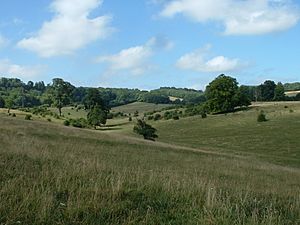Tring Park facts for kids
| Site of Special Scientific Interest | |
 |
|
| Area of Search | Hertfordshire |
|---|---|
| Grid reference | |
| Interest | Biological |
| Area | 35.6 hectares |
| Notification | 1986 |
| Location map | Magic Map |
Welcome to Tring Park! It's a fantastic open space in Tring, a town in Hertfordshire, England. This park is looked after by the Woodland Trust and owned by Dacorum Borough Council. It's a really special place because it's part of the Chilterns Area of Outstanding Natural Beauty. Imagine a huge area of rolling hills and beautiful countryside – that's the Chilterns!
About half of Tring Park, which is about 107 hectares (or 264 acres), is made up of grassy fields where cattle sometimes graze. A special part of the park, along with a nearby area called Oddy Hill, is known as a Site of Special Scientific Interest (SSSI). This means it's a very important place for nature and wildlife. The "Oddy Hill and Tring Park" SSSI covers 35.6 hectares.
Contents
A Look Back: The Park's History
Tring Park used to be the private grounds of a grand house called Tring Park Mansion. This mansion was built way back in 1682 by a famous architect named Christopher Wren. He designed many important buildings, including St Paul's Cathedral in London! Later, in the 1800s, the outside of the mansion was changed a bit.
In the early 1700s, a landscape designer named Charles Bridgeman helped create the beautiful gardens and grounds you see today. He even worked with another famous architect, James Gibbs, who designed some of the smaller buildings in the park, like a summerhouse. Tring Park is so important historically that English Heritage has given it a special "Grade II" listing. This means it's recognized as a building or park of special historic interest in England.
A Special Place for Nature
The two main areas of the SSSI (Oddy Hill and Tring Park) are mostly grassy slopes on chalk hills. These areas are home to a huge variety of plants, including some very rare ones!
Plants and Animals of the Park
Most of the park's grassy areas are kept healthy by grazing animals, like cattle. But in some sloped areas, there's a lot of ungrazed scrub (bushes and small trees). This scrub is a perfect home for many different insects and other small creatures, as well as a great spot for birds to build their nests and raise their young. It's a busy place for wildlife!
Exploring the Park: Paths and Monuments
As you walk through the park, especially in the wooded parts of the Chiltern hills, you'll find old paths that were once used for horse-drawn carriages.
King Charles Ride
One of these old paths is called King Charles Ride, or sometimes the King's Ride. This path is now part of a longer walking route called the Ridgeway National Trail. Imagine walking the same paths that people used hundreds of years ago! In 2013, some work began to make King Charles Ride even better. They started replanting a circle of lime trees at a spot called the 'rond point' and improved the views over the park and the town of Tring.
Historic Monuments
In the northeast part of the park, you'll find two more special monuments that are also "Grade II listed."
- One is a tall, pointed stone pillar called an obelisk. Locals sometimes call it Nell Gwynne's monument.
- The other is the beautiful summerhouse, which has a grand entrance with four large columns, looking a bit like a small temple. These are great spots to visit and imagine what the park was like long ago!




